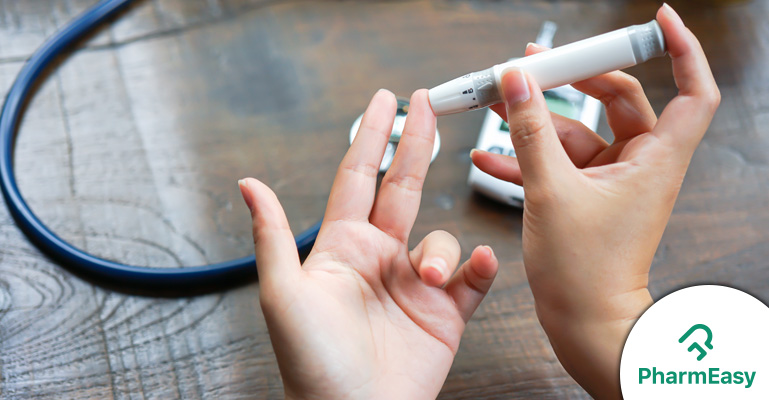Different Types Of Blood Sugar Levels You Should Know!
By Dr. Nikita Toshi +2 more

Get,

to manage your symptom
Get your,


4 Cr+ families
benefitted

OTP sent to 9988776655



You’ve successfully subscribed to receive
doctor-approved tips on
Whatsapp

Get ready to feel your best.

Hi There,
Download the PharmEasy App now!!


Register to Avail the Offer
Send OTPBy continuing, you agree with our Privacy Policy and Terms and Conditions

Hi There,
Sign up on PharmEasy now!!
Trusted by 4 crore+ families

OTP sent to 9988776655



You have unlocked 25% off on medicines




Code: NU25



By Dr. Nikita Toshi +2 more
Table of Contents
Diabetes, also known as Diabetes mellitus, in medical parlance, falls under a group of metabolic diseases, where a patient has high blood sugar (glucose). This is a serious global disease that has gripped people of various age groups across multiple nationalities.

Diabetes typically occurs due to:
The American Diabetes Association (ADA) has identified the below set of people to be susceptible to diabetes:
1. People with a body mass index higher than 25 and 23 in the case of Asian-Americans. This is regardless of age. But the chances of getting diagnosed with diabetes increases manifold if the following conditions also prevail:
2. The Association also recommends diabetes testing to be done on a regular basis for people above the age group of 45 years and if the results are within the prescribed limits then tests should be repeated every three years.
3. Any woman who has had gestational diabetes should get herself checked every three years.
Some common symptoms that diabetic patients experience include:
More often than not, the diagnosis of diabetes includes carrying out a urine test. This test reveals whether there is excess glucose present in the body. This is typically followed up with a blood test to calculate the blood sugar levels. Since a patient cannot feel whether the blood sugar is high or low, this testing needs to be conducted at regular intervals, sometimes even several times in the day, to keep a check on the sugar levels.
FPG stands for ”Fasting Plasma Glucose”. This is the blood sugar level when you have been fasting for at least 8 hours. This is usually checked a couple of hours after one wakes up in the morning and primarily helps in the diagnosis of diabetes and pre-diabetes. While you are not permitted to consume anything for 8 to 10 hours before taking the test, you can consume water at regular intervals.
The FPG results typically fall under the below readings:
PPG stands for ”Postprandial Plasma Glucose”. This is the after-meals blood sugar level that is usually checked one to two hours post eating. This testing is generally done to check the spike in the blood sugar level post eating and is usually done to check how tolerant the body is to glucose.
The PPG results typically fall under the below readings:
Another important number that the ADA prescribes is the A1C number, which is also popularly known as Glycated Hemoglobin, Glycosylated Hemoglobin, Hemoglobin A1C, and HbA1c.
This is a very important number that basically describes how well your blood sugar has been controlled over the past 2 to 3 months. It also tells your diabetes control team how effectively your overall diabetes control plan is working. In a nutshell, your A1C Control = FPG Control + PPG Control.
The A1C test measures what percentage of your haemoglobin is coated with sugar (glycated). Haemoglobin is a protein in red blood cells that carries oxygen. The higher the A1C level, the poorer is your blood sugar control and the higher is the risk of developing diabetes-related complications. The A1C test plays a vital role in predicting prediabetes, type 1 diabetes, and type 2 diabetes.
Good control over the A1C helps to safeguard the body from numerous diabetes-related risks such as:
These are microvascular complications that primarily cause damage to small blood vessels.
Along with these, there are some macrovascular problems too that damage the large blood vessels. These include:
This type of diabetes typically occurs during childhood or during the adolescence stages. This diabetes type requires regular insulin treatment, generally for life, to keep the blood sugar levels in control.
This is the most common and prevalent kind of diabetes. It usually develops in adulthood and is mostly observed in people who are largely inactive or overweight. Read more about the symptoms of type 2 diabetes.
Administration of oral drugs is given when lifestyle modifications have been unsuccessful in bringing down the blood sugar levels. These oral doses work well to treat Type 2 diabetes, but Type 1 patients have to resort to insulin injections or insulin pumps.
Disclaimer: The information provided here is for educational/awareness purposes only and is not intended to be a substitute for medical treatment by a healthcare professional and should not be relied upon to diagnose or treat any medical condition. The reader should consult a registered medical practitioner to determine the appropriateness of the information and before consuming any medication. PharmEasy does not provide any guarantee or warranty (express or implied) regarding the accuracy, adequacy, completeness, legality, reliability or usefulness of the information; and disclaims any liability arising thereof.
Links and product recommendations in the information provided here are advertisements of third-party products available on the website. PharmEasy does not make any representation on the accuracy or suitability of such products/services. Advertisements do not influence the editorial decisions or content. The information in this blog is subject to change without notice. The authors and administrators reserve the right to modify, add, or remove content without notification. It is your responsibility to review this disclaimer regularly for any changes.

Leave your comment...

View all comments(1)
[…] is said to be pre-diabetic or have pre-diabetes only when the blood glucose level or the blood sugar levels are higher than usual. However, the blood glucose levels are not as high as those considered for a […]